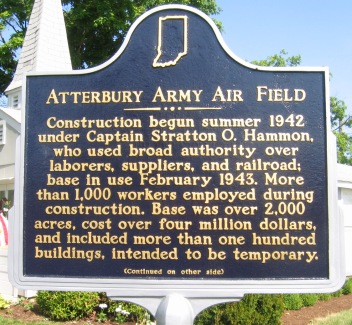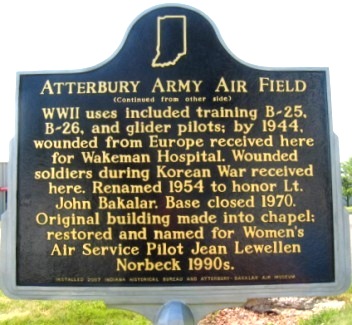

Location: In front of chapel at Middle Road and Grissom Avenue, Atterbury Army Air Field, Columbus (Bartholomew County, Indiana)
Installed: 2007 Indiana Historical Bureau and Atterbury-Bakalar Air Museum
ID# : 03.2007.2
![]() Visit the Indiana History Blog to learn how POW's at Camp Atterbury contributed to agricultural needs during WWII.
Visit the Indiana History Blog to learn how POW's at Camp Atterbury contributed to agricultural needs during WWII.
Text
Side one:
Construction begun summer 1942 under Captain Stratton O. Hammon, who used broad authority over laborers, suppliers, and railroad; base in use February 1943. More than 1,000 workers employed during construction. Base was over 2,000 acres, cost over four million dollars, and included more than one hundred buildings, intended to be temporary.
Side two:
WW II uses included training B-25, B-26, and glider pilots; by 1944, wounded from Europe received here for Wakeman Hospital. Wounded soldiers during Korean War received here. Renamed 1954 to honor Lt. John Bakalar. Base closed 1970. Original building made into chapel; restored and named for Women's Air Service Pilot Jean Lewellen Norbeck 1990s.
Keywords
Military
Annotated Text
Atterbury Army Air Field(1)
Side one:
Construction begun summer 1942(2) under Captain Stratton O. Hammon,(3) who used broad authority over laborers, suppliers, and railroad;(4) base in use February 1943.(5) More than 1,000 workers employed during construction.(6) Base was over 2, 000 acres, cost over four million dollars, and included more than one hundred buildings, intended to be temporary.(7)
Side two:
WW II uses included training B-25, B-26, and glider pilots;(8) by 1944, wounded from Europe received here for Wakeman Hospital.(9) Wounded soldiers during Korean War received here.(10) Renamed 1954 to honor Lt. John Bakalar.(11) Base closed 1970.(12) Original building made into chapel; restored and named for Women's Air Service Pilot Jean Lewellen Norbeck 1990s.(13)
Notes:
(1)In 1941 Congress passed spending bills that would allow for rapid construction of military bases throughout the country. Lou Thole, "Building an Airfield: Atterbury Army Air Field, Columbus, IN, " in Thole, Forgotten Fields of America, World War II Bases and Training THEN and Now(Missoula, Mont., 1996), www.71stsos.com/buildingatterburyfield.html (accessed January 20, 2005) (B00216).
During World War II, twenty-seven military posts built in Indiana, bringing the total number of bases in Indiana to twenty-nine in 1945. These included seven airfields, two hospitals, six storage depots, a proving ground, eight ordnance works, and five training camps and stations. Dorothy Riker, Hoosier Training Ground: A History of Army and Navy Training Centers, Camps, Forts, Depots, and Other Military Installations within the State Boundaries during World War II (Bloomington, 1952), 2 (B00035).
Note: Atterbury Army Air Field was distinct base from Camp Atterbury, which was finished in summer 1942 a few miles north of where the air base would be laid out. As originally conceived, Atterbury Army Air Field was intended to allow ground troops (Camp Atterbury) and air troops (Atterbury Army Air Field) to learn to work together in combat. Riker, Hoosier Training Ground, 80 (B00035).
(2)"Daily Work Record of Captain Stratton O. Hammon, " in Stratton O. Hammon Papers, Filson Historical Society, Louisville, Ky., http://www.indianamilitary.org/ATTERBURYAAF/Hammon Diary/Hammon Diary.htm (accessed March 17, 2005) (B00221); "Engineers Get Set for Work on Plane Base, " Columbus Evening Republican, August 4, 1942 (B00065); "Actual Work on Air Base Is Started Today, " Columbus Evening Republican, August 19, 1942 (B00567).
(3)"Engineers Get Set" (B00065). At the time Hammons took over the job of building the air base, he was 38 years old and had been an architect for 22 years. In December, with base nearly complete, promoted from captain to major and oversaw building of three more army fields, a general hospital, quartermaster depot, medical depot, and other structures. Stratton Hammon, "The Impact of World War II on a Citizen Soldier, " speech, n.d., www.indianamilitary.org (accessed March 17, 2005) (B00224).
(4)To make room for the base, fourteen families were forced to sell their property to the government. "Early Break in Airfield Story Here Expected, " Columbus Evening Republican, July 30, 1942 (B00569); "War Department Is Granted Land for Flying Field, " Columbus Evening Republican, August 8, 1942 (B00568); "South Line of Air Base Moved Half-Mile North, " Columbus Evening Republican (B00570). Some farmers were originally reluctant to move, so Hammon obtained a court order to move them. Hammon, "Impact of World War II" (B00224).
In order to finish base on time, Hammon needed a railroad spur to the base to ship in ten carloads of cement per day. Originally Pennsylvania Railroad refused to install spur until other military obligations were met. Hammon ignored the military chain of command and appealed directly to the head of the War Production Board. Two days later, the spur was being built. Also, according to Hammon, the presence of labor union organizers was slowing production.
Hammon claimed to have phoned the draft board in Indianapolis asking why the union leaders on his base had not been drafted. According to Hammon, those organizers soon disappeared from the base. Hammon, "Impact of World War II" (B00224).
Crews at times poured concrete all night long. There is also a reference in the following article to the black workers living in cabins on the bases while the while workers were living in a separate, recently vacated farm on the base. "Work Keeps Air Base Boys Warm, " Columbus Evening Republican, October 28, 1942 (B00571). For more on the sometimes drastic measures Hammon took to finish the base on time, see his "Daily Work Record" (B00221).
(5)"Daily Work Record" (B00221); "Bakalar: Little City in Hawpatch, " Columbus Evening Republican, December 9, 1965 (B00572). (6)"900 Men Labor on New Air Base North of City, " Columbus Evening Republican, September 30, 1942 (B00573).
(7)"Columbus Will Get Camp Atterbury Air Support Base, " Franklin Evening Star, August 4, 1942 (B00575); "Air Base to Be Built Mile North of Town, " Columbus Evening Republican, August 3, 1942 (B00574); "Bob Takes a Peep in a Jeep at New Air Base, " Columbus Evening Republican, November 28, 1942 (B00576); Riker, Hoosier Training Ground, 2 (B00035).
(8)"Personnel at Military Posts Undergoes Cut, " Columbus Evening Republican, August 20, 1943 (B00578); "B-26 Bombers, Crews Arrive at Local Base, " Columbus Evening Republican, September 11, 1943 (B00577); "Another Cut Is Announced at Atterbury AAF, " Columbus Evening Republican, March 13, 1944 (B00579); "Local Atterbury AAF Activity to Be Given to Freeman AAF, " Columbus Evening Republican, September 19, 1945 (B00580).
(9)"Local Atterbury AAF Activity" (B00580). At one point during the war, Wakeman was largest hospital in the Fifth Service Command. The hospital ultimately housed 85, 000 patients. For more on Wakeman Hospital, see Riker, Hoosier Training Ground, 42-68 (B00035).
After World War II, base used periodically for pilot training. "Air Base Review Planned Friday, " Franklin Evening Star, July 31, 1952 (B00581); Lou Thole, "Building an Airfield" (B00216).
(10)"War Casualties Arrive at Camp, " Franklin Evening Star, October 20, 1950 (B00582).
(11)"Air Force Dedicates Bakalar Base as Hoosier War Hero's Son Watch, " Indianapolis Star, November 14, 1954 (B00590).
(12)"3 Hoosier Bases Hit by Military Cut, " Indianapolis Star, October 28, 1969 (B00591); "Bakalar AFB Employes [sic] To Close Shop, " Indianapolis Star, April 6, 1970 (B00593).
Base given to City of Columbus 1972. "U.S. Giving Bakalar to Columbus, " Indianapolis Star, December 3, 1971 (B00688); Lou Thole, "Building an Airfield" (B00216).
(13) The building that became the chapel was one of the original buildings constructed in 1942. It served as a barracks until 1951 or 1952, when it was converted into a chapel. Atterbury-Bakalar Air Museum (Columbus, Ind.), http://www.atterburybakalarairmuseum.org/prod04.htm (accessed January 10, 2005).
Norbeck (1912-1944), a Columbus native, was one of 38 women pilots killed in service during World War II and the only woman from Bartholomew County killed in the line of duty. Stationed in Sumter, South Carolina, as a test pilot for planes that had been marked unsafe, on October 16, 1944, she was killed when the plane she was piloting crashed. Wynita Worley, "Chapel Honors Woman Pilot, " Columbus Republic, May 30, 1998 (B00698).
In 1995, the local Aviation Board began a restoration of the former air base. During the process, the board determined that one of the few remaining buildings should be dedicated to a war hero. Norbeck was selected for the honor, and the restored chapel was dedicated to her on May 29, 1998. Ibid (B00698).
